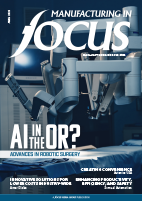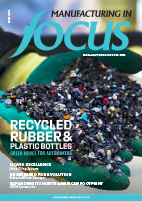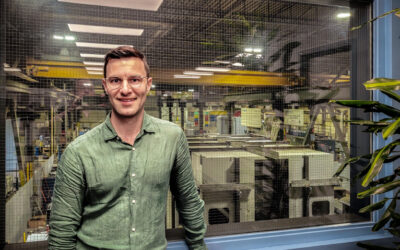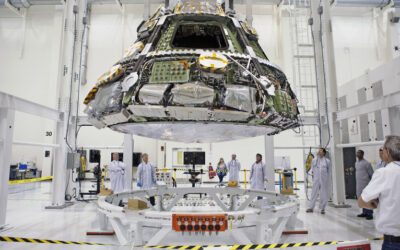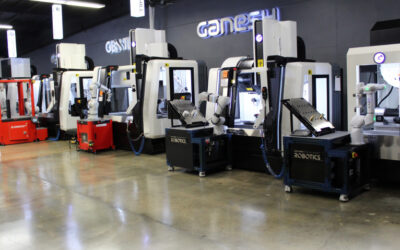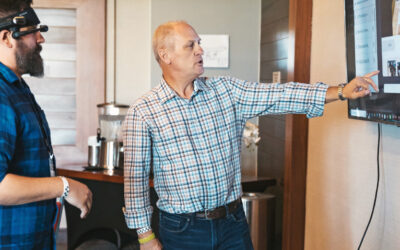‘Speed Wins’ is the slogan of Clinkenbeard, a fast-rising firm that specializes in the rapid production and prototyping of complex machined parts and metal castings. Headquartered in South Beloit, Illinois, this company is known for more than just fast turnaround times. It has also been recognized for the quality of its work and its expertise in making mock-ups, among other items.
Clinkenbeard boasts a computer numerical control (CNC) department with five-axis, three-axis, and two-axis machines, a foundry pattern and model shop, a paint shop, sand molding shop, and a cutting-edge metrology lab. The company offers in-house sand mold and core-making services, uses the latest computer-aided design/computer-aided manufacturing (CAD/CAM) software and has been growing at a rapid clip in recent years.
“The growth comes from aggressively going after large programs. We want to grow. We don’t want to be stagnant. So, we’ve been aggressive in our sales efforts,” explains Reg Gustafson, Vice President of Business Development.
Growth can also be attributed to Clinkenbeard’s ability to combine fast service with high quality. “Speed is a result of a speed mindset which includes our whole workflow – order entry, ordering all necessary raw material and tooling, engineering in a way which reduces time. Operating lean [helps as well],” he explains.
“When we get a purchase order, it doesn’t sit in somebody’s inbox for a week,” he adds. “Within a couple hours, we have the order entered into our system. We’re ordering materials. We’re prepping our people on the floor.”
The ‘Speed Wins’ mindset also encompasses quick delivery; the company will even arrange for hand delivery of critical parts or products to clients if need be.
Clinkenbeard counts aerospace, heavy truck and engine, the U.S. government, power generation, industrial, auto racing, agriculture, marine, and space as its main markets. “Industrial covers a lot of different segments, anything from power tools to industrial compressors, that kind of thing,” says Gustafson.
The sector generating the largest revenue for the company “swings from year to year, but right now we’re heavy in the aerospace industry,” he adds. “Mostly military but we do some civilian as well.”
Traditionally, Clinkenbeard focused on short-runs, custom manufacturing anywhere from one to one hundred pieces or so according to client specifications, but that has changed in the last five years. “We have been known for short-runs, but we have recently expanded into short-run production machining,” he says. Short-run, in this instance, means aerospace quantities rather than automotive quantities. “It’s hard to change the customer base’s thinking to include production since we have been a prototype shop since the 1960s.”
Most of its services are self-performed, and this is a point of pride for the company. Some work such as chemical processing or heat treatment is subcontracted, however. “It’s hard to be good at everything,” states Gustafson.
“We supply products which are used in our customers’ systems. Our customers can decide if they want to use our services or not, and they’re only going to come to us if we offer a good value proposition. We spend significant amounts of time and money exploring technology and methods which will compress delivery, eliminate waste, and save money. These efforts strengthen our value proposition,” he says.
One thing that Clinkenbeard is particularly good at is making mock-up models of products for promotion or training. Mock-ups can either be full-sized or scaled-down. One notable project involved creating a mock-up of an F-35 Joint Strike Fighter plane turbine engine.
Gustafson refers to the F-35 engine mock-up as a training device for Air Force mechanics and says making such items entails “a combination of our core competencies including engineering services and concurrent customer engineering support, foundry patterns and machined sand castings, CNC hog-outs using solid stock metal and non-metallic raw material.” Hog-outs are machined prototype components.
Clinkenbeard has also built mock-ups of turbine engines for civilian aircraft makers to display at aerospace trade shows.
This focus on aerospace mock-ups seems appropriate, given the company’s origins. The firm was launched in 1966 by Hitchcock Industries, now part of Consolidated Precision Products, a Minneapolis-based foundry that specialized in castings for the aerospace industry. Satellite operation Clinkenbeard was established as a pattern shop to make castings for aerospace clients. The name came from the family name of an early partner.
Clinkenbeard thrived and moved into other fields besides aerospace. Over the decades, it developed a reputation for forward thinking when it came to new technology. For example, it has been using CNC machines and digital data for machining for decades. The company’s early embrace of these technologies put it far ahead of other manufacturers.
Today, it can claim expertise in CNC machining with a focus on vertical milling centers and turning centers and CAD/CAM technology. Aluminum and iron castings can be made from a customer’s three-dimensional CAD models. Down the road, Clinkenbeard is thinking about getting into the metal, additive-manufacturing field.
In addition to being an enthusiastic proponent of technology, the company has come up with some cutting-edge solutions of its own. For example, the company developed something called the ‘Clinkenbeard Toolingless Process’ for making metal castings.
“The process was developed in the 2001 timeframe. The investment casting industry used additive patterns to eliminate tooling for early prototypes. We did the same with the sand-casting process because nobody else was doing so. Our goal was to eliminate tooling and the associated costs and lead time. We can also modify sand molds and cores made using production tooling in order to incorporate and test engineering changes very quickly,” says Gustafson.
Clinkenbeard’s technological focus is complemented by quality control. The company has AS9100D certification, ITAR registration, and a systematic approach to quality assurance. Among other gear, its metrology lab contains coordinate measuring machines (CMMs) which use probes to precisely measure objects. A quality manager and quality technician are on staff, and quality control meetings are held each day.
The company’s ‘Speed Wins’ philosophy does not mean that it sacrifices quality. Parts are checked for quality throughout the work process, and the presence of cutting-edge laser-scanning equipment means thorough inspections can be done speedily.
“After a part is completed, it doesn’t take a week to inspect the part; it takes a day. We’re always looking for the fastest piece of equipment that can help us reduce those lead times,” states Gustafson.
This intense push for quality has earned the company industry kudos. In March 2015, Clinkenbeard was named ‘Plant of the Year’ by Quality Magazine. The honor was given in recognition of the company’s “dedication to quality, speed and continuous improvement,” explained the publication. “That was a nice win,” Gustafson reflects.
Clients seem to appreciate Clinkenbeard’s approach. Business has been so good lately that it just moved into bigger digs. To avoid downtime, the move was done in a phased fashion, starting in late 2018 and ending in early 2019. “We doubled our square feet. We’re about 40,000 square feet now with land to expand and double our size again,” reports Gustafson.
Clinkenbeard is vertically integrated with production machining division M2M Machining. “We do cross-sell and reduce customer costs by sharing information when handing the baton from prototype to production,” he says.
“We’ve been doing some interesting projects in the space industry mostly with regards to training mock-ups, for training astronauts basically. I can’t go into detail because we signed non-disclosures. It is an interesting field to be working in. There’s a race between billionaires all trying to get into space right now. They’re investing in materials, additive manufacturing, five-axis milling,” he says.
“Finding skilled people,” is the biggest challenge facing Clinkenbeard at present, says Gustafson.
Not only is Clinkenbeard faced with a national skilled trades shortage as older workers retire and not enough young workers enter the profession to replace them, but the specialized nature of much of what the company does poses another hiring hurdle. “We’re a niche business. We’re not like many other machine shops that do really simple parts,” he states.
For all that, he remains highly optimistic about the future. While aerospace and training devices represent potential areas for growth, Gustafson wants to maintain a broad range of clients.
“We are definitely looking to grow our business. Aerospace looks like it will be a strong market for years to come. Defense-related training mock-ups look to be a strong niche business for us. We want to have a good mix, however. So, we also support heavy truck, heavy engine, and power generation,” he says.
“We don’t have any specific sales goals,” he says of the next few years. “We are working on updating our strategic plan. We will have specific goals in the strategic plan. We will try to maintain our profit level margins. We don’t worry about sales as much. We think sales will come.”



